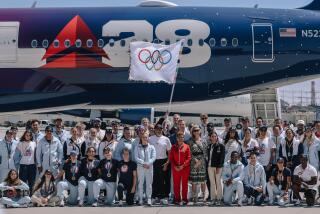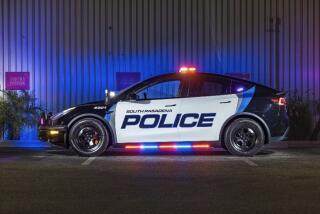Surging Forward : Cities Gear Up for State Mandate With Plans for Electric Vehicles
Seven million dollars will buy a lot of extension cords, but that is not what the AQMD had in mind when it set aside all that money to jump-start the modern era of electric cars in Southern California.
Most of the money will be doled out to help bring down the cost of the noiseless, exhaust-free runabouts, and some is also expected to help build charging stations and repair shops along the Santa Monica (10) Freeway corridor.
Already, a surge of interest in alternative-fuel vehicles is flickering among private hobbyists and city governments on the Westside.
In Santa Monica, a gangly, purple solar-charging stations is rising in the City Hall parking lot. Paid for by a grant from the South Coast Air Quality Management District, the solar panels will pour juice into City Hall by day. The city’s electric-powered vehicles will charge up there at night.
In West Hollywood, the city is building a charging station into its new public parking structure, while in Culver City, city workers have been testing an electric-powered truck supplied by Southern California Edison Co.
In Los Angeles, officials of the city Department of Water and Power are charged up by the idea of up to a million electric-powered cars taking the place of gas-guzzlers on streets and freeways. That’s how many cars the DWP and Edison expect to be able to power without suffering any impact on their electrical capacity.
The source for all this energy is a state-mandated requirement that 2% of the cars sold in California by 1998 be powered by alternate fuels. The U.S. Department of Energy is considering similar action for publicly owned car fleets.
The issue is not without controversy. The AQMD set aside objections from taxpayer groups and oil industry representatives when it approved the $7 million Quick Start program last month, and automobile manufacturers have said they may not be ready to meet the state’s demands by 1998.
And for now, at least, electric cars are still about as rare as electric eels in Santa Monica Bay.
But Tom Doughty, director of electric transportation for the DWP, said that the air quality management district’s Quick Start program means “you begin to awaken the giant--that giant being the market.”
The AQMD expects to underwrite the cost of up to 1,200 vehicles through Quick Start, which is funded by a $4 annual motor vehicle registration fee.
With the program’s $5,000 discount and the state and federal tax breaks for electric-car buyers, the cost of a major manufacturer’s electric car would be reduced from about $30,000 to a more affordable $22,000, he said.
Doughty hopes to make the Westside a testing ground for the dream of a battery-powered motoring future.
“It’s a relatively affluent community, it’s an environmentally aware community and it’s relatively densely populated,” he said.
The details have yet to be worked out, but the idea is to create a corridor of public and private charging stations all along the 10 Freeway from Santa Monica to Redlands.
The presence of quick-charging 220-volt plugs at convenient locations would make the electric-powered buggy much more appealing.
The DWP has a special low rate for nighttime charging of electric cars, and most homes are already wired for 220-volt electricity, which is used for dryers and washing machines.
The good news for drivers is the low operating cost--about $1 for an overnight charge--and a clean environmental conscience, since electric cars are projected to be 97% cleaner than gas-powered vehicles even when power-plant pollution is factored in.
“I just like the idea of not polluting--and as long as we’re dependent on oil, we’re at risk in the world,” said Greg Glenn, a Pacific Palisades resident who retrofitted a sleek 1974 Fiat Bertone X/1-9 sports car.
The vehicle throbs with the noise of the Fiat’s original transmission, but the lack of motor noise is almost spooky. To add a humorous note, Glenn fitted the car with a recording of the cough and whine of an internal combustion engine starting up.
So where to buy one, you may ask? Well, hardly anywhere for now, although GM recently loaned prototypes of its electric-powered Impulse speedster to notables like Disney Chairman Michael Eisner and Superior Court Judge Lance A. Ito for two-week test drives.
Users reported that the car met their daily driving needs about 83% of the time, the DWP said.
As for major manufacturer models, the first are expected to go on sale to the public as early as the fall of 1996. The electric car industry could create 24,000 jobs in the region by the year 2003, according to an estimate by UCLA researchers.
For now, a few used electric cars are traded through hobbyists’ newsletters and tinkerers like Glenn Roach of Torrance, who will convert a gasoline-powered car in his garage for $10,000 or more. Roach drives a retrofitted VW Beetle he calls the Voltswagon.
Retired AQMD engineer Saxe Dobrin, a Santa Monica resident, Has commissioned Roach to make over a brand-new Chevy S10 truck just because he believes in it.
“I applaud him taking funds out of his pocket, out of his children’s inheritance, for me to make prototypes,” Roach says with a laugh, but Dobrin, a fuel engineer who started his career in rockets, doesn’t mind.
He’s out to set an example, he said. “I learned long ago that technical matters are a lot less important than economical and political ones.”
Now the enthusiasts are praying for one more boon: the invention of a lightweight yet powerful battery. Nearly a century ago, electric cars rivaled the popularity of gas-powered automobiles, but eventually lost out because of the bulk and weight of their batteries.
“We’ve been dreaming of a super battery for 75 years. If we hit it, most of the automobiles in our cities will be electric,” said 80-year-old Jamison Handy, who zips around the Pacific Palisades in a 1932 Detroit Electric that once belonged to the actress ZaSu Pitts.
With few moving parts, like all electric cars, his buggy rarely needs maintenance. But the old Detroit Electric recently made a rare trip to the shop--for reupholstering.
“The moths finally got to it,” Handy said.
More to Read
Sign up for Essential California
The most important California stories and recommendations in your inbox every morning.
You may occasionally receive promotional content from the Los Angeles Times.









